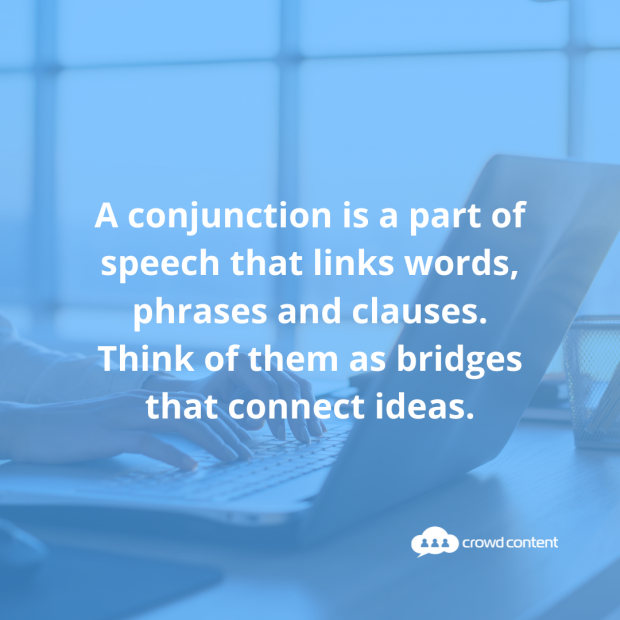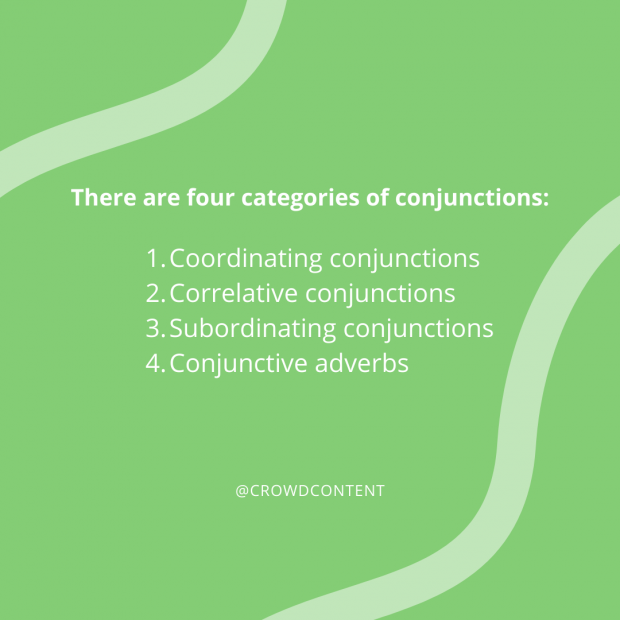Types of Conjunctions: What They Are and How to Use Them
Types of Conjunctions
Let’s be honest. Conjunctions aren’t very exciting. They’re not as descriptive as nouns, as colorful as adjectives or as dynamic as verbs. However, these small but mighty parts of speech are a critical part of your writer’s tool kit. Different types of conjunctions help you to smooth out choppy writing, bring together ideas, and build flowing complex sentences.
When you understand how these grammatical elements fit together, you can structure your writing better and become a stronger content writer. Let’s run through some conjunction examples, the four types of conjunctions, and what to watch for when you’re putting these words to work.
What’s a Conjunction?
A conjunction is a part of speech that links words, phrases and clauses. Think of them as bridges that connect ideas. Conjunctions fall into one of four categories based on how they’re used.

What Are Some Examples of Conjunctions in Sentences?
Coordinating conjunction example:
- He can’t get a ride, so he has to stay home.
Correlative conjunction example:
- I don’t know whether he’s getting a ride or staying home.
Subordinating conjunction example:
- Because he can’t get a ride, he has to stay home.
Conjunctive adverb:
- He can’t get a ride; therefore, he has to stay home.
What are Some Common Conjunctions?
Below are lists of common conjunctions you can use in your writing, and there are plenty to pick from. These lists aren’t exhaustive, except for the coordinating conjunctions.
Coordinating conjunctions list
Some people use the mnemonic “fanboys” to remember the seven coordinating conjunctions.
- for
- and
- nor
- but
- or
- yet
- so
Correlative conjunctions list
- either/or
- neither/nor
- not only/but also
- as/as
- both/and
- whether/or
Subordinating conjunctions list
- after
- although
- as soon as
- because
- before
- by the time
- in case
- now that
- since
- unless
- when
- whether or not
- while
Conjunctive adverbs list
- after all
- besides
- consequently
- finally
- however
- nevertheless
- then
- therefore
What are the Types of Conjunctions?
There are four categories of conjunctions:
- Coordinating conjunctions (or, and, but)
- Correlative conjunctions (and/or, not only/but also)
- Subordinating conjunctions (since, because, when)
- Conjunctive adverbs (however, therefore)

Here’s a closer look at how to use them and what to watch for in terms of punctuation and construction.
1. Coordinating Conjunctions
Coordinating conjunctions are single words (example: and, but, or, so).
They link equivalent grammatical elements, such as nouns with nouns, and clauses with clauses. The ideas being connected carry the same weight in a sentence.
- I stayed up all night writing, so I was tired the next day
- She’s editing and proofreading my essay.
What to watch for when using coordinating conjunctions:
When a coordinating conjunction joins two independent clauses (complete thoughts or sentences), use a comma between the clauses.
- I can’t remember the rules, so I need a refresher.
When you’re joining an independent clause and a dependent clause (incomplete thought), you don’t need a comma.
- I prefer to write on my laptop but edit on paper.
2. Correlative Conjunctions
Correlative conjunctions work in pairs (example: either/or, both/and, not only/but also, as/as)
Similar to coordinating conjunctions, they link grammatical elements of similar importance.
- I not only passed the exam, but also got 100%.
- The box is as tall as it is wide.
What to watch for when using correlative conjunctions:
Correlative conjunctions need parallel construction. Check the words after each conjunction and make sure they’re similarly structured.
- Correct: We should either book the tickets in advance or arrive an hour early. (In this example, the phrase “book the tickets” is parallel to “arrive an hour early”)
- Incorrect: We should either book the tickets in advance or be arriving an hour early. (In this example, the phrase “book the tickets” is not parallel to “be arriving”)
3. Subordinating Conjunctions
Subordinating conjunctions are one or more words that unite ideas in a complex sentence (example: as soon as, in case, unless, while).
They link dependent clauses (incomplete thoughts) to independent clauses (complete thoughts).
- Unless we give him a ride, he won’t be able to come.
- Here’s some cash in case your credit card doesn’t work.
The subordinating conjunction is placed in front of the dependent clause. As Cambridge Dictionary explains, subordinating conjunctions modify the independent clause and provide a cause, reason, result or purpose.
What to watch for when using subordinating conjunctions:
Use a comma if the subordinating conjunction and dependent clause are at the beginning of a sentence. Otherwise, the comma isn’t required.
- As soon as she’s finished her phone call, we’ll leave for the restaurant.
- We’ll leave for the restaurant as soon as she’s finished her phone call.
4. Conjunctive Adverbs
Conjunctive adverbs are one or more words used to join two independent clauses (example: after all, besides, nevertheless).
These words are technically adverbs, but perform the same linking function as conjunctions.
What to watch for when using conjunctive adverbs:
When a conjunctive adverb unites two independent clauses in one sentence, it’s preceded by a semicolon and followed by a comma.

- The dessert is so tempting; however, I’m trying to eat less sugar.
- We’re happy to pay for your expenses; after all, you’re doing us a favor.
Connect With Crowd Content and Further Your Freelance Career
Interested in developing your writing skills with the support of our content managers and editors? Our innovative platform provides access to exciting projects such as blog posts, product descriptions and SEO content. Sign up for an account and join our writing team today!